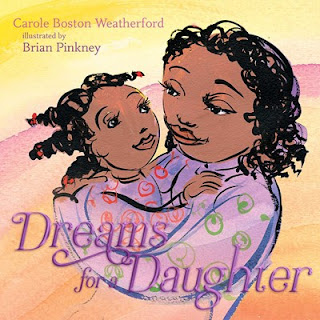How do you bundle all of a parent's dreams and love for a child together in one book? How do you help children see all their potential? Two new picture books do a lovely job of just this, and I'll be bringing them with me this weekend to celebrate my daughter Katy's college graduation.
by Carole Boston Weatherfordillustrated by Brian PinkneyAtheneum / Simon & Schuster, 2021ages 4-adult
This love letter from mother to daughter captures a mother's love and hopes, inspiring her daughter to follow her dreams, no matter what challenges life may bring. "Your voice is my heart song... I look on as you hit your stride... I marvel as you follow your own compass." Carol Boston Weatherford's words speak to me, reaching right into my heart. I'll be reading this to Katy this weekend, for sure! "In the stands, I cheer.. You are my champion and I am yours. / You are braver than you think. / From writing rhymes and painting rainbows to building robots, / your gifts amaze me." Brian Pinkney's illustrations overflow with joy, love and warmth, drawing on a young Black girls' experiences and connecting to universal feelings.
Someone Builds the Dreamby Lisa Wheelerillustrated by Loren LongDial / Penguin, 2021ages 4-8
Building homes, bridges, any project starts with an idea, but it takes so many different people to make them actually happen. This picture book celebrates all of those people, from the designers to the scientists to the carpenters and welders. We need to recognize not just the folks who dream up the plan, but also those who put it in action. "Someone needs to raise the tower. / Someone has to build the dream." This picture book will appeal to all the kids out there who love building things, but it will also pull in the dreamers and designers.
Lisa Wheeler's text is a joy to read aloud, flowing with natural rhythm and delightful rhymes. Loren Long's illustrations honor so many types of workers, and I especially appreciate how diverse (in so many ways) the workers are. I'll read it this weekend, and think about how "it takes a team to build a dream, / a skilled, hard-working crew." And I hope my daughters find a place to dream, to work with a team, to be their best selves.
 |
| Reading with Molly & Katy |
We loved reading together, whether it was Sandra Boynton's fabulous board books (Hippos Go Berserk! is her definite favorite) or Silly Sally (which I think I still have memorized).
Here's to Katy, a wish that she follows her dreams, surrounds herself with friends, and celebrates her best self. She's an amazing young woman!
 |
| Katy, class of 2021 |
The review copies are from my public library. If you make a purchase using the Amazon links on this site, a small portion goes to Great Kid Books. Thank you for your support.
©2021 Mary Ann Scheuer, Great Kid Books























